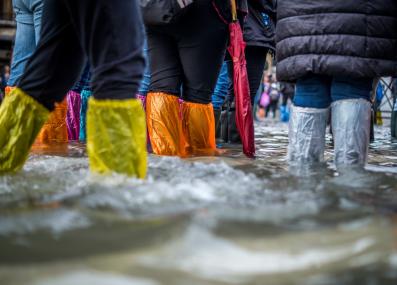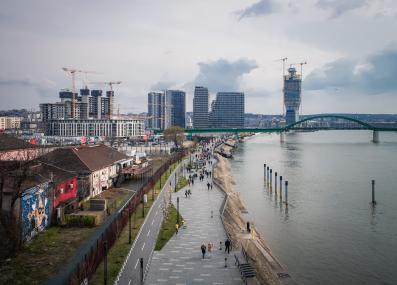Have a question?
How will coastal residents first experience the effects of sea level rise?
People on the coasts may find that the biggest effects from rising seas will come from the groundwater below their feet.
April 22, 2022
Sea level along American coastlines could rise by up to one foot by 2050, according to a recent report by a group of U.S. government agencies including NASA, NOAA, and USGS. When thinking about sea level rise, people often imagine waves that lap up onto beaches, boardwalks, houses and streets, causing annoying, damaging or even catastrophic floods.
But in fact, the effects of sea level rise might not look like waves washing in from the sea. Long before that happens, people living near coastlines may experience flooding in their basements and a greater frequency of flooding during high tide.
As sea levels rise, so does the water table, which is how far down you'd have to dig in order to hit water. Charles Harvey, MIT professor of civil and environmental engineering, explains that in many places, the level of the water table is determined by a complex series of factors including local climate and geology. But at the coastlines, Harvey says, the story is much simpler: the water table is directly tied to sea level.
Brent Minchew, MIT assistant professor of geophysics, explains that the pressure exerted by the ocean itself is proportional to the height of the water table. So as melting glaciers and ice sheets add more water to the world’s oceans and as ocean water expands as it warms, the extra water not only raises sea level but also increases the pressure that the ocean exerts to push groundwater higher.
Harvey says a rising water table can cause a variety of problems. Consider a coastal city where the water table has risen already because of higher sea levels—like Oakland, California.1 When the ocean is at high tide, that extra water pushes the underground water table even closer to the surface.
“Then if you get a lot of rain at that time,” Harvey says, “it can't be [taken up] by the soil. So you get flooding from rain, that you would not have had without this particularly high tide—and you wouldn't have this particularly high tide without sea level rise.” This is already a worsening issue in low-lying places like Florida, he says. Because of rising seas, such places already face an increasing risk of “sunny day flooding,” when high tide events such as the full moon cause inundation in low-lying areas even if it isn’t raining.
Rising groundwater can bring a variety of damaging effects, even for those who don’t live right near the ocean. Basements could be more vulnerable to flooding. Pipes would be at risk for damage, and septic tanks broken in this way could contaminate local water.2 As salty seawater intrudes the land, it can raise salinity levels underground, which taints our freshwater and damages our soil.3
And unlike the case of encroaching waves, where better coastal defenses and sea walls could help to keep the water at bay, Harvey says there’s little we could do to combat a rising water table. Countries like Denmark and the Netherlands have been successful for many years at pumping out seawater to keep their low-lying areas from flooding, but this is an expensive and difficult feat of engineering. Harvey says places that have clay or low- permeability bedrock in their soils near the surface will have better luck preventing seawater from flowing underground.
“For the coastlines of the world, and particularly countries without huge resources, I don’t see it happening,” he says. “There is one thing we could do: stop putting greenhouse gases into the atmosphere.”
Thank you to Ann Sawyer of Greenwich, Connecticut, for the question. You can submit your own question to Ask MIT Climate here.
1 "Groundwater beneath your feet is rising with the sea. It could bring long-buried toxic contamination with it." By Laura Klivans, KQED. December 15, 2020. Accessed April 22, 2022.
2 "How rising groundwater caused by climate change could devastate coastal communities." By Kendra Pierre-Louis, MIT Technology Review. December 13, 2021. Accessed April 22, 2022.
3 Hassani, A., Azapagic, A. & Shokri, N. "Global predictions of primary soil salinization under changing climate in the 21st century." Nature Communications 12, 6663, 2021. doi:10.1038/s41467-021-26907-3









